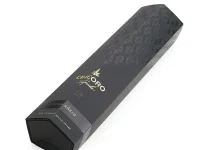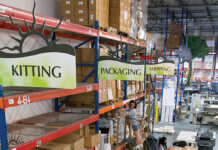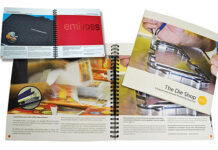by Jen Clark, The Binding Edge
With run quantities getting smaller and more print communications going online, Dillon Bindery, Milwaukee, WI, had a decision to make. The family-owned business staked a claim by specializing in 2008; it became the first trade bindery in Wisconsin to offer high-speed, large-run PUR binding utilizing the open pot application. “The wide variety of paper and coating combinations are becoming more challenging and specialty jobs attempting to grab the reader’s attention are becoming more complex, which makes the use of PUR adhesive that much more important,” said Joshua Schroeckenthaler, vice president.
It wasn’t the first time that Dillon Bindery had diversified its offerings to meet its customers’ changing needs. Roy Schroeckenthaler purchased the small company in 1953, retained its name and operated it out of rented space on the third floor of its present location. As the business grew, so did Dillon Bindery’s reputation as a quality provider of binding and finishing services. Roy Schroeckenthaler purchased the building in 1964 and moved operations to the first floor. In 1978, the company began offering perfect binding, recognizing the need to diversify because of changing technology and greater demand for specialized service.
In 1997, Dillon Bindery expanded into mechanical binding. When Roy retired three years later, his son David Schroeckenthaler purchased the business. The company’s growth continued and in 2005, it added an automatic book drilling line. In 2008, it added a second perfect binding line. In 2010, Dillon Bindery added two more automatic book drilling lines and converted its other perfect binder to PUR, enabling the company to offer PUR on all perfect bound books.
Much of the company’s growth occurred in the midst of the worst recession since the Great Depression. According to Printing Industries of America, the Great Recession, which officially lasted from December 2007 to June 2009, shrunk print’s economic footprint by historic proportions. In 2008, the number of US printing plants declined to 33,565 and employment dropped to 909,200. The industry lost another 2,943 plants and more than 67,000 employees in 2009. Despite this, David Schroeckenthaler said, Dillon Bindery’s “growth was required to meet the needs and demands of our customers.”
Overcoming Obstacles with PUR
PUR adhesive is an alternative to other binding adhesives in the paperback book binding industry. It aids in overall performance and is a solution to ever increasing paper changes. “Printers are using more high-end products that require a lot of different coatings on the paper,” Joshua explained. “They are constantly changing the coatings and ink coverage. They’re also using heavier stocks. It was becoming a problem to get the book to perform the way the customer wanted it to.” Added David, “PUR overcomes a lot of those obstacles.”
In most cases, PUR is used to enhance the performance of page pulls and flexes to make a stronger book. A variety of factors, including proper spine preparation and residual print solvents, influence the ability of an adhesive to perform. Short fibers from recycled paper reduce the ability of an adhesive to bond to pages, while coated stocks, clay, aqueous coatings, varnishes and/or UV coatings can be difficult surfaces to bond. In addition, signature thickness and mixed paper stock can add stress to the glue line.
PUR-bound books have higher performance levels than similarly bound books using standard hot melt (EVA). The thin, tough and flexible nature of PUR enables the pages to open easily and have some lay-flat characteristics, “although PUR is not lay-flat binding,” David noted. PUR is resistant to a variety of inks and solvents, which can cause EVA hot melts to fail and leads to costly rebinds. In addition, PUR offers resistance to temperature extremes, which is beneficial during shipping and storage.
The combination of a poor adhesive with an inferior application method can be disastrous. Most binderies that offer PUR, Joshua explained, use the spray-on method because it is more economical. “They go with that because there is a waste factor,” he said. “Once PUR is exposed to air, it starts to set up or cure. So, they go with the spray-on system because it is more cost-effective as far as wasting the glue is concerned. Glue is expensive.”
Dillon Bindery utilizes the open pot application method, meaning technicians fill up the pot at the beginning of the day and drain it at the end of the day, repeating the process each day. “This process requires us to discard about $90 worth of glue between both binders each day,” Joshua estimated. “It becomes a cost factor for some people, but we’re not looking to save cost on the material. We’d rather put together a higher quality product instead of worrying about saving money on the material.”
Besides, the spray-on method has a higher spine failure rate, he added. “People view PUR as a magic glue, but it’s not just ‘a glue.’ It’s the application process. It’s how you prep the book and apply the glue. The spine preparation and the glue still is a big part of making sure you have a successful product at the end.”
The Schroeckenthalers agreed that PUR binding has become the company’s specialty. “Our customers can bind with a variety of stocks and coatings,” David said. “They aren’t limited to what they can use. They don’t have to worry about full ink coverage or the coverage of their coating.”
Dillon Bindery works closely with its glue supplier and tests various kinds of adhesives each year. The company uses leftover stock from previous projects to see what glue works best. “We don’t feel that all products are the same,” Joshua said. “There are a lot of people out there who use PUR, but they’re pretty price-conscious. They’re more driven by the price of the product, not how it performs.”
After thorough testing, deciding which adhesive to use is based on performance, not the company’s bottom line. “It can make a big difference at the end of the year on how much you spend on glue,” David said. “But if you have a job that needs to be reprinted because the glue failed, you’re responsible for that.”
Being educated with the advancement of adhesive technology and products is an important factor. BC Adhesives, Franklin, WI, helps Dillon Bindery in that regard. It specializes in the food processing and general purpose packaging, graphic arts and publishing, paper converting and product assembly and construction markets. BC Adhesives offers a hands-on relationship to its clients. It offers a strong portfolio of the leading adhesive brands, technical expertise and intimate knowledge of the complete range of customer production equipment and product substrates.
“They have an extensive knowledge of the book binding process,” Joshua said. “There are a lot of suppliers out there who sell glue, but they don’t know anything about how it is used or the process. They’ve never even seen the machine that they’re using it for. BC Adhesives puts in a lot of time and they have a lot of knowledge about the binding process. If there’s ever a problem, they are right there to help you out. They are staying on top of the new products that are coming from the different glue companies.” The results of the collaboration are clear. In the five years since Dillon Bindery started running PUR in the open pot application, they haven’t had any spine failures.
Custom Quoting Program Gives Competitive Edge
A computer-based, in-house quoting system that David developed about 12 years ago gives Dillon Bindery greater flexibility when quoting new jobs and analyzing completed jobs. It helps to track costs – start to finish – for each project. When he started building the system, there were other quoting systems on the market, but they were geared more toward printers with in-house binderies, Joshua explained. “Other programs lacked the detail and flexibility required to consider the many variables associated with the binding process,” David said.
Because the software was developed completely in-house, it allows Dillon Bindery to make changes on a regular basis. “Since we are constantly quoting, if there are things that need to be changed or tweaked, we can do it right away,” he said. “We are quoting every day. We see little things here or there. The way we have it set up, when we’re done with a job, we can analyze time sheets and cross reference that with the quoting data. It is very simple in how it is set up. It shows a lot of detail that we can use to analyze the time sheet afterwards.”
The software tracks factors like quantity, stock, material cost, labor cost, machine cost – “everything it takes to put a book together,” David said. It also shows comparisons on different ways of processing a job. “It can tell us which option is the most economical choice.”
A lot of the custom jobs Dillon Bindery works on have small- to medium-size run lengths. “The software will tell us exactly what our costs are for a particular project,” he said. “When we look at the time sheets, we can see exactly how much time was spent on a job as far as machine time, labor hours, etc., and we can go back to the quote to see exactly how the quote compares to the amount of time actually spent doing the job. It allows us to take all the costs of the material added into the final time sheets and gives us an exact analysis of how the job turned out compared to how we quoted it. We can see if adjustments need to be made in our quoting or not.”
The process has allowed Dillon Bindery to stay competitive, while keeping an eye on the bottom line. “Materials, including adhesive, are constantly changing in price,” Joshua said. “The software allows us to analyze that better. It gives us a better understanding of what it costs to do business.”
Humble Beginnings with an Eye on the Future
Dillon Bindery operates out of the same building it did when Karl Dillon founded the company in the 1930s. Its central location within the Milwaukee metropolitan area makes it convenient for local customers. Interstate access is also available for customers from as far away as Green Bay, Steven’s Point, Madison, Chicago and Indiana.
The company leans on its 70 years of book binding, magazine binding and catalog, calendar and brochure graphics arts finishing experience to produce high quality professionally bound publications to serves small, medium and large printers from its 25,000 sq. ft. facility. In addition to PUR and EVA perfect binding, it has a variety of mechanical wire binding, stitching (stapling) and folding capabilities for binding projects where a professionally bound look at a low price point is essential. Equipment at Dillon Bindery includes two Osako saddlestitchers, a Christensen Gang Stitcher, two Kolbus perfect binders, a 30-pocket Duplo booklet maker, five folders, three Durselen automatic drilling machines, two cutters, twin loop and plastic coil binders, along with miscellaneous equipment for eyeletting and elastic tag stringing.
Looking forward, the Schroeckenthalers see continued research and improvements in the PUR binding application and streamlined manufacturing in all processes. “We’ll continue to educate printers regarding the PUR process and the advantages it offers over conventional EVA perfect binding,” Joshua Schroeckenthaler said, noting the company may add inkjet capabilities in the future.
Keeping the business in the family has allowed the Schroeckenthalers to be very hands on with the operation. In addition to father, David, and son, Joshua, there are two other family members on staff. “We all started out in the shop – probably at the bottom moving waste, sweeping the floor,” David Schroeckenthaler said with a chuckle. “It’s been a long time. We’ve all been in the business for a long time now.”
In addition to David and Joshua, family members Anthony Schroeckenthaler and LoRonda Schroeckenthaler also are employed with the bindery as a machine operator and human resources manager/office assistant, respectively. Dillon Bindery also has 20 employees, many of whom have been with the company as long as the second- and third-generation family members. “We have very little turnover,” Joshua said. He attributed that longevity and loyalty with the company’s flexibility and the knowledge that they aren’t just employees. “We make them feel like they are part of the team.”




